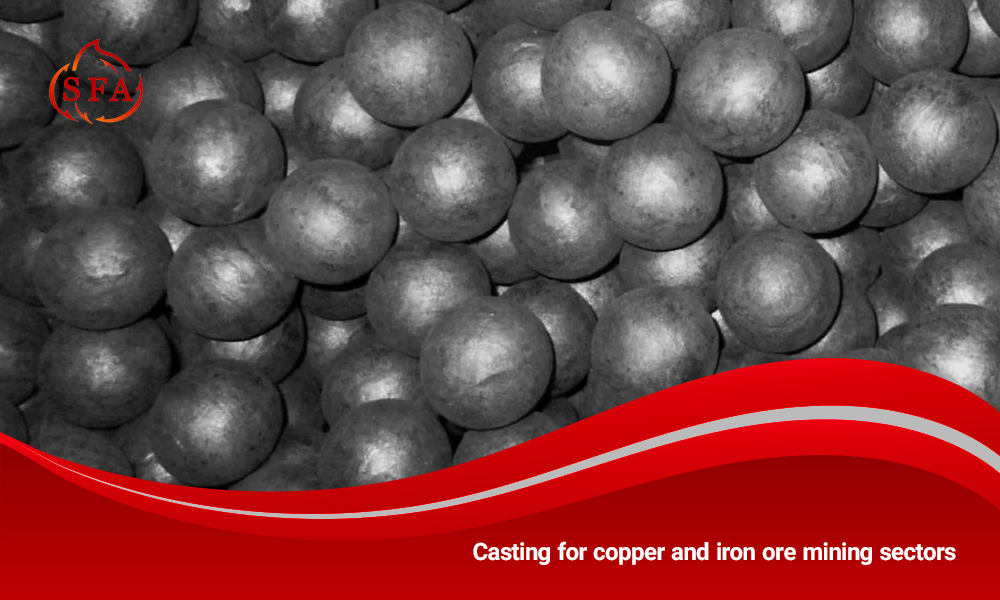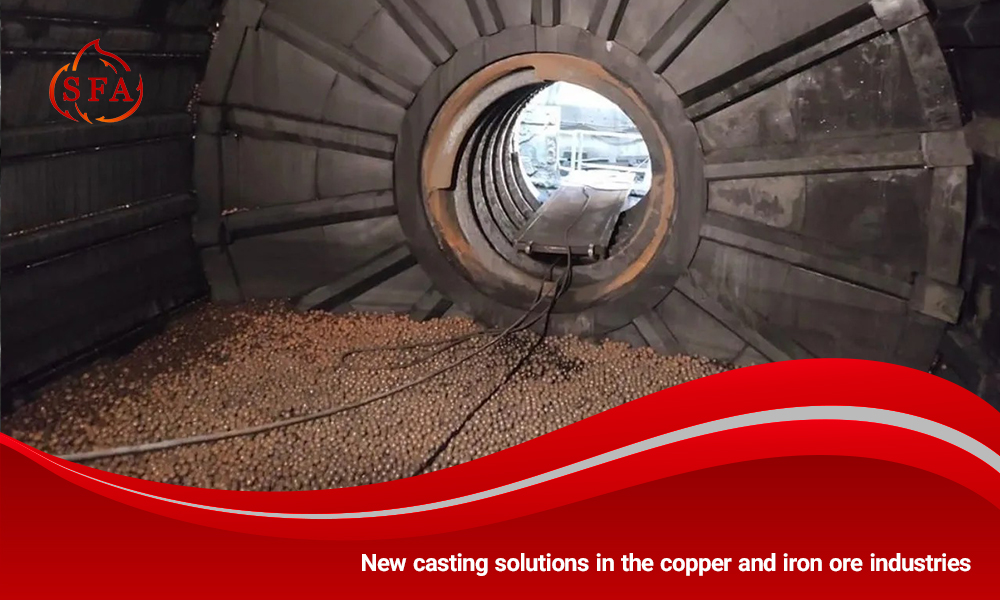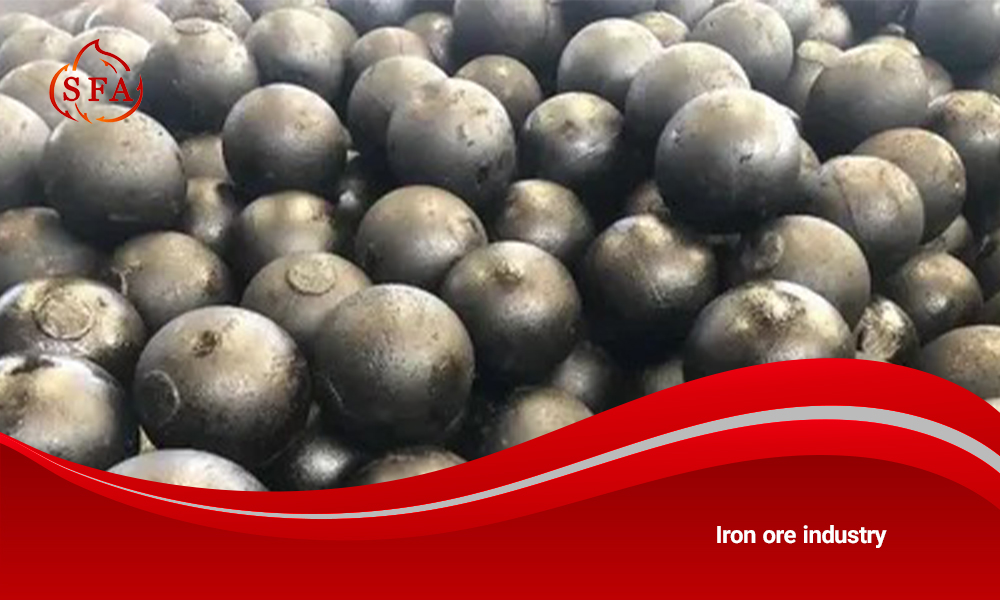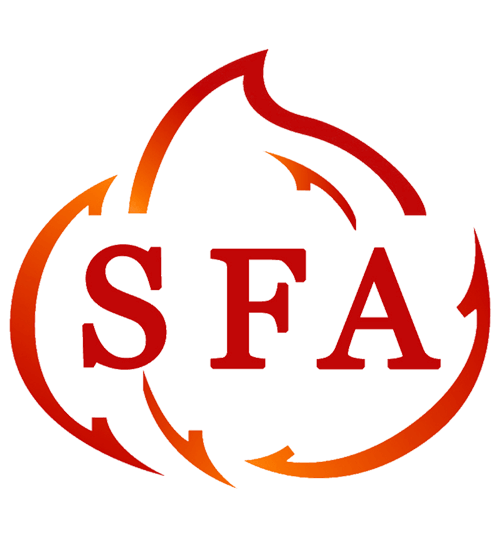

Casting Solutions for the Copper and Iron Ore Mining Sectors
The copper and iron ore mining industry relies on the production of heavy equipment and spare parts with very high resistance. Machines such as ball mills and AG/SAG, crushers, conveyors and pumps involved in ore crushing and concentration operations operate under extremely abrasive and impact conditions. For this reason, the use of casting parts with special alloys is a vital requirement. Casting plays a key role in these sectors, as it allows the production of large complex parts with controlled metallurgical properties and optimal cost.
For example, Ni-Hard cast iron alloys with high nickel and chromium offer exceptional hardness and wear resistance, making them ideal for mining equipment with severe wear. Hadfield manganese steel, containing more than 12% manganese, provides impact and wear hardening and is widely used in high-impact parts. Overall, casting for copper and iron ore mining sectors helps increase equipment lifespan, reduce depreciation, and improve mining process safety. Stay with us until the end of this article from Sepahan Foolad Atashgah.
Needs and challenges of casting in copper and iron ore mines
The copper and iron ore industries require castings with specific specifications due to the hard and abrasive nature of the raw materials. The most important needs and challenges in this area are:
High abrasion and impact resistance:
Ore masses contain abrasive particles (sand, gravel) and various types of crushing equipment such as asterisks and mill linings must be resistant to continuous wear. Ni-hard and manganese alloys perform outstandingly in these conditions due to their carbide structure and high hardness.
Corrosion resistance:
In copper mining, the processing section uses acidic solutions, such as sulfuric acid, which expose components like slurry pumps and valves to chemical corrosion. Ni-resist cast irons (high in nickel) and stainless steels are designed for such corrosive environments and offer superior durability.
Thermal and thermal operations:
Some mining equipment is in contact with hot materials or in the vicinity of smelting furnaces (e.g. hoods and mouths of copper furnaces). Hence creep and temperature resistance are important. Castings of aluminum-bronze alloys (for heat resistance), and nickel-chromium alloy steels (for high temperature stability) are solutions to these needs.
High dimensional accuracy and dimensional accuracy:
Mining castings are generally very large and complex (e.g. SAG and AG mill liners). The precise production of these parts requires advanced equipment and molding so that minimal turning is required after machining. Any casting defect or porosity can lead to machine failure. For this reason, complete quality control at all stages of production is essential.
Cost and delivery time:
Producing large parts as specialized castings is time-consuming. Therefore, reducing mold manufacturing time and optimizing processes is very important. The lower cost of casting, compared to making parts from cast steel, while providing the same properties, is a key advantage. Operators must balance part durability, achieved through the right alloy and process control, with reducing downtime. Improving the alloy and casting process directly extends equipment life and reduces maintenance and replacement costs.


New casting solutions in the copper and iron ore industries
To meet the above needs, the foundry industry is adopting a range of solutions, including the selection of appropriate alloys, advanced molding techniques, and modern production equipment. Some of the most important of these solutions are:
Wear-resistant alloys
1. Ni-hard cast iron: White cast irons with high nickel and chromium content, which are decorated with a martensitic structure and wear-resistant carbides. These alloys have very high hardness and significant wear resistance, suitable for mill liners, crusher blades, and other parts subject to severe wear.
2. Ni-resist cast iron: Austenitic cast irons with high nickel content that, in addition to good wear resistance, have good thermal stability and chemical resistance. These alloys are used for pump parts and valves in slurry pelletizing and copper refining.
3. High-Chromium Cast Irons: White cast irons containing 12–18% chromium, which are rich in chromium carbides in their structure. Due to their high hardness and excellent wear resistance, they are an effective choice for rotating mill linings and feed pump parts. These cast irons are less expensive than high-chromium steels and perform very well in moderate abrasion and impact conditions.
4. Manganese Steel (Hadfield): An alloy with 11–14% manganese and 1% carbon, originally developed by Hadfield. This steel, with its impact hardening property, gains very high wear resistance and maintains high toughness during work. For this reason, it is used in parts such as hammers, bushings, and mine crusher parts that are subjected to severe impacts.
5. Bronzes and Copper Alloys: Aluminum bronze and magnesium bronze alloys are used for high-friction rotating parts such as bearings in mills and pumps. These alloys have good wear resistance, reduce friction and adhesion, and are resistant to aqueous corrosion.
Click to read the article «Improving Mining Mill Efficiency with Premium Cast Balls».
Advanced molding methods:
1. Automated sand casting: The use of machined sand casting machines with automatic control of sand quality and temperature ensures more stable production and better repeatability of large-scale parts.
2. Casting with 3D printed patterns: Using 3D printers to produce patterns or sand molds significantly reduces mold preparation time. It also enables the production of complex geometries. Research has shown that 3D printed or CNC-cut casting patterns are effective in large mineral parts and increase delivery speed.
3. Vacuum and pressure casting: In some sensitive parts with thin sections, the use of vacuum or pressure during casting provides better compaction in the part and reduces internal defects.
4. Casting process simulation: Simulation software helps engineers model melt flow and cooling and predict and correct common defects such as porosity, thermal cracking, and gas porosity before actual production.
New equipment and technologies
1. Advanced melting furnaces: High-efficiency induction furnaces with large capacities (for example, a set of 7 melting furnaces with a simultaneous capacity of 20,000 kg) allow for rapid and homogeneous melting of alloys.
2. Quality control laboratories: Leading companies such as Sepahan Foolad Atashgah are equipped with advanced NDT, metallography, and chemical analysis laboratories, which guarantee the quality of manufactured parts at all stages up to the final stage.
3. Management and standardization: Implementing integrated quality management systems (ISO and international standards) ensures castings meet engineering specifications. It also aligns production with the needs of large mining industries.
By combining these solutions, industrial parts for copper and iron ore mines gain high strength, resistance, and special properties such as shear wear resistance and impact strength. Companies like Sepahan Foolad Atashgah, using advanced technical knowledge and fully equipped laboratories, produce complex, high-quality parts tailored to mining industry needs.
Adapting solutions to the requirements of the copper and iron ore industries
The above solutions are applied specifically depending on the characteristics of each section of copper and iron ore mines:
Copper industry:
In addition to abrasion loads, copper mines are associated with corrosion problems caused by chemicals. For example, sulfuric acid and corrosive solutions in copper processing can corrode metal equipment. In critical parts such as slurry pumps and drilling valves, Ni-resist cast irons and austenitic stainless steels withstand corrosive conditions. In the copper flash-plating process, parts like the hood and mouth of the copper converter furnace or the ball mill liner must endure extreme temperatures and corrosion; Sepahan Foolad Atashgah specializes in producing these components.
Overall, an appropriate casting solution in copper mines includes corrosion-resistant alloys such as Ni-resist and chemical-resistant coatings. It also requires providing parts based on detailed copper extraction and processing plans.
Iron ore industry:
Iron ore processing mainly involves crushing hard and abrasive rocks. In these conditions, Ni-hard cast irons and manganese steels are preferred. Liners of AG/SAG mills and ball mills are generally made from high-manganese or Ni-hard cast irons to withstand severe impact and wear. Cone covers and gonoes of jaw and cone crushers typically use high-chromium Ni-hard cast iron. In this industry, the production of bulky parts with high precision and structural integrity is important; in such a way that Sepahan Foolad Atashgah has been able to meet the needs of iron ore mines by providing long-life AG/SAG liners. With this strategy, the total cost of ownership is reduced and the reliability of the equipment is increased.
In short, casting for copper and iron ore mining sectors involves adapting alloys and casting processes to each industry’s unique challenges, such as corrosion in copper and severe abrasion in iron ore. Using nickel- and magnesium-containing alloys for impact-resistant parts and chromium-containing alloys for sliding or abrasive environments has proven highly effective. To reduce import dependence and strengthen the supply chain, supporting domestic manufacturers like Sepahan Foolad Atashgah and developing the casting parts network has become increasingly important.


Sepahan Foolad Atashgah Company’s capabilities in the field of mineral
Sepahan Foolad Atashgah Foundry Industries Company, with over 30 years of experience, leads the domestic market in supplying parts to the steel, copper, mining, and cement industries. The company operates seven melting furnaces, each with a 20,000-kilogram capacity, across a 25,000-square-meter production area, and produces approximately 25,000 tons of industrial casting parts annually. More than 250 specialists, including experienced engineers and operators, drive research and development of new alloys and processes.
In the copper and iron ore mining sector, Sepahan Foolad Atashgah has the ability to produce many key components. For example, the company designs and manufactures AG and SAG mill liners to the highest standards. In the copper industry, the company provides components such as copper converter hoods, mouths, and highly durable ball mill liners. These successes result from strict quality control, advanced NDT and metallography laboratories, and an integrated quality management system. Consequently, Sepahan Foolad Atashgah exports world-class castings to Europe and the Middle East, in addition to serving the domestic market.
In short, “Casting for copper and iron ore mining sectors” in Iran is gradually advancing through specialized companies and indigenous technologies. Sepahan Foolad Atashgah, as a leading example, has earned the trust of major mining industries and supports a bright future for self-sufficiency in strategic sectors.
For more information and specialized advice, contact the company’s experts and CEO.
Conclusion
Casting plays a key role in providing durable and economical components for copper and iron ore mines. This paper shows that using special alloys, such as Ni-hard, manganese steel, high-chromium cast irons, and advanced bronzes, significantly increases the life of mining equipment. Combining these alloys with modern casting methods reduces maintenance costs. Companies like Sepahan Foolad Atashgah, with long experience and complete laboratory facilities, meet these requirements effectively.


